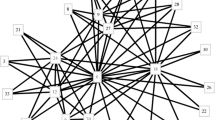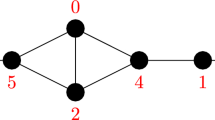Abstract
A C-coloured graph is a graph, that is possibly directed, where the edges are coloured with colours from the set C. Clique-width is a complexity measure for C-coloured graphs, for finite sets C. Rank-width is an equivalent complexity measure for undirected graphs and has good algorithmic and structural properties. It is in particular related to the vertex-minor relation. We discuss some possible extensions of the notion of rank-width to C-coloured graphs. There is not a unique natural notion of rank-width for C-coloured graphs. We define two notions of rank-width for them, both based on a coding of C-coloured graphs by \({\mathbb{F}}^{*}\)-graphs—\(\mathbb {F}\)-coloured graphs where each edge has exactly one colour from \(\mathbb{F}\setminus \{0\},\ \mathbb{F}\) a field—and named respectively \(\mathbb{F}\) -rank-width and \(\mathbb {F}\) -bi-rank-width. The two notions are equivalent to clique-width. We then present a notion of vertex-minor for \(\mathbb{F}^{*}\)-graphs and prove that \(\mathbb{F}^{*}\)-graphs of bounded \(\mathbb{F}\)-rank-width are characterised by a list of \(\mathbb{F}^{*}\)-graphs to exclude as vertex-minors (this list is finite if \(\mathbb{F}\) is finite). An algorithm that decides in time O(n 3) whether an \(\mathbb{F}^{*}\)-graph with n vertices has \(\mathbb{F}\)-rank-width (resp. \(\mathbb{F}\)-bi-rank-width) at most k, for fixed k and fixed finite field \(\mathbb{F}\), is also given. Graph operations to check MSOL-definable properties on \(\mathbb{F}^{*}\)-graphs of bounded \(\mathbb{F}\)-rank-width (resp. \(\mathbb{F}\)-bi-rank-width) are presented. A specialisation of all these notions to graphs without edge colours is presented, which shows that our results generalise the ones in undirected graphs.








Similar content being viewed by others
Notes
G[X] is oriented (or undirected) if G is oriented (or undirected).
Note that symmetric and skew-symmetric matrices are σ-symmetric.
References
Adler, I., Bui-Xuan, B., Rabinovich, Y., Renault, G., Telle, J.A., Vatshelle, M.: On the Boolean-width of a graph: structure and applications. In: Thilikos, D.M. (ed.) WG, LNCS, vol. 6410, pp. 159–170. Springer, Berlin (2010)
Bui-Xuan, B., Habib, M., Limouzy, V., de Montgolfier, F.: Unifying two graph decompositions with modular decomposition. In: Tokuyama, T. (ed.) ISAAC, LNCS, vol. 4835, pp. 52–64. Springer, Berlin (2007)
Bui-Xuan, B., Telle, J.A., Vatshelle, M.: H-join decomposable graphs and algorithms with runtime single exponential in rank-width. Discrete Appl. Math. 158(7), 809–819 (2010)
Bouchet, A.: Digraph decompositions and Eulerian systems. SIAM J. Algebr. Discrete Methods 8(3), 323–337 (1987)
Bouchet, A.: Circle graph obstructions. J. Comb. Theory, Ser. B 60(1), 107–144 (1994)
Blumensath, A., Courcelle, B.: Recognisability, hypergraph operations and logical types. Inf. Comput. 204(6), 853–919 (2006)
Corneil, D.G., Habib, M., Lanlignel, J., Reed, B.A., Rotics, U.: Polynomial time recognition of clique-width≤3 graphs. In: Gonnet, G.H., Panario, D., Viola, A. (eds.) LATIN, LNCS, vol. 1776, pp. 126–134. Springer, Berlin (2000)
Courcelle, B., Engelfriet, J., Rozenberg, G.: Handle-rewriting hypergraph grammars. J. Comput. Syst. Sci. 46(2), 218–270 (1993)
Courcelle, B.: Basic notions of universal algebra for language theory and graph grammars. Theor. Comput. Sci. 163(1–2) 1–54 (1996)
Courcelle, B.: The monadic second-order logic of graphs XV: on a conjecture by D. Seese. J. Appl. Log. 4(6), 79–114 (2006)
Courcelle, B., Engelfriet, J.: Graph Structure and Monadic Second-Order Logic: A Language Theoretic Approach. Encyclopedia of Mathematics and Its Applications, vol. 138. Cambridge University Press, Cambridge (2012)
Courcelle, B.: On the model-checking of monadic second-order formulas with edge set quantifications. Discrete Appl. Math. (2012, to appear). doi:10.1016/j.dam.2010.12.017
Courcelle, B., Kanté, M.M.: Graph operations characterising rank-width. Discrete Appl. Math. 157(4), 627–640 (2009)
Courcelle, B., Makowsky, J.A.: Fusion in relational structures and the verification of monadic second-order properties. Math. Struct. Comput. Sci. 12, 203–235 (2002)
Courcelle, B., Makowsky, J.A., Rotics, U.: Linear time solvable optimisation problems on graphs of bounded clique-width. Theory Comput. Syst. 33(2), 125–150 (2000)
Courcelle, B., Olariu, S.: Upper bounds to the clique-width of graphs. Discrete Appl. Math. 101(1–3), 77–114 (2000)
Courcelle, B., Oum, S.: Vertex-minors, monadic second-order logic and a conjecture by Seese. J. Comb. Theory, Ser. B 97(1), 91–126 (2007)
Cunningham, W.H.: Decomposition of directed graphs. SIAM J. Algebr. Discrete Methods 3(2), 214–228 (1982)
Diestel, R.: Graph Theory, 3rd edn. Springer, Berlin (2005)
Ehrenfeucht, A., Harju, T., Rozenberg, G.: The Theory of 2-Structures: A Framework for Decomposition and Transformation of Graphs. World Scientific, Singapore (1999)
Fellows, M., Rosamond, F.A., Rotics, U., Szeider, S.: Clique-width is NP-complete. SIAM J. Discrete Math. 23(2), 909–939 (2009)
Fisher, E., Makowsky, J.A., Ravve, E.V.: Counting truth assignments of formulas of bounded tree-width or clique-width. Discrete Appl. Math. 156(4), 511–529 (2008)
Flarup, U., Lyaudet, L.: On the expressive power of permanents and perfect matchings of matrices of bounded pathwidth/cliquewidth. Theory Comput. Syst. 46(4), 761–791 (2010)
Fon-Der-Flaass, D.G.: Local complementation of simple and directed graphs. In: Discrete Analysis and Operations Research, vol. 1, pp. 15–34 (1996)
Ganian, R., Hliněný, P., Obdrzálek, J.: Unified approach to polynomial algorithms on graphs of bounded (bi-)rank-width. (2012, submitted)
Ganian, R., Hliněný, P., Obdrzálek, J.: Better algorithms for satisfiability problems for formulas of bounded rank-width. In: Lodaya, K., Mahajan, M. (eds.) FSTTCS, LIPIcs, vol. 8, pp. 73–83. Schloss Dagstuhl—Leibniz-Zentrum fuer Informatik, Saarbrücken (2010)
Ganian, R., Hliněný, P., Kneis, J., Langer, A., Obdrzálek, J., Rossmanith, P.: On digraph width measures in parameterized algorithmics. In: Chen, J., Fomin, F.V. (eds.) IWPEC, LNCS, vol. 5917, pp. 185–197. Springer, Berlin (2009)
Ganian, R., Hliněný, P.: On parse trees and Myhill-Nerode-type tools for handling graphs of bounded rank-width. Discrete Appl. Math. 158(7), 851–867 (2010)
Ganian, R., Hliněný, P., Kneis, J., Meister, D., Obdrzálek, J., Rossmanith, P., Sikdar, S.: Are there any good digraph width measure? In: Raman, V., Saurabh, S. (eds.) IPEC, LNCS, vol. 6478, pp. 135–146. Springer, Berlin (2010)
Geelen, J.F., Gerards, A.M.H., Whittle, G.P.: Branch-width and well-quasi-ordering in matroids and graphs. J. Comb. Theory, Ser. B 84(2), 270–290 (2002)
Geelen, J.F., Gerards, A.M.H., Robertson, N., Whittle, G.P.: On the excluded minors for the matroids of branch-width k. J. Comb. Theory, Ser. B 88(2), 261–265 (2003)
Geelen, J.F., Gerards, A.M.H., Whittle, G.P.: Excluding a planar graph from GF(q)-representable matroids. J. Comb. Theory, Ser. B 97(6), 971–998 (2007)
Geelen, J.F., Gerards, A.M.H., Whittle, G.P.: Towards a matroid minor structure theory. In: G. Grimmett and C. McDiarmid (eds.) Combinatorics, Complexity and Chance—A Tribute to Dominic Welsh, Chap. 5
Hliněný, P.: Branch-width parse trees, and monadic second-order logic for matroids. J. Comb. Theory, Ser. B 96(3), 325–351 (2006)
Hliněný, P.: The tutte polynomial for matroids of bounded branch-width. Comb. Probab. Comput. 15(3), 397–409 (2006)
Hliněný, P., Oum, S.: Finding branch-decompositions and rank-decompositions. SIAM J. Comput. 38(3), 1012–1032 (2008)
Kaminski, M., Lozin, V.V., Recent, M.M.: Developments on graphs of bounded clique-width. Discrete Appl. Math. 157(12), 2747–2761 (2009)
Kanté, M.M.: The rank-width of directed graphs. arXiv:0709.1433 (2008)
Kanté, M.M.: Well-quasi-ordering of matrices under Schur complement and applications to directed graphs. Eur. J. Comb. (2012, accepted). doi:10.1016/j.ejc.2012.03.034. arXiv:1102.2134
Kanté, M.M., Rao, M.: Directed rank-width and displit decomposition. In: Paul, C., Habib, M. (eds.) WG, LNCS, vol. 5911, pp. 214–225. Springer, Berlin (2009)
Kanté, M.M., Rao, M.: Bipartitive decomposition of 2-structures. Manuscript (2010)
Lipschutz, S.: Schaum’s Outline of Theory and Problems of Linear Algebra, 2nd edn. McGraw-Hill, New York (1991)
Lidl, R., Niederreiter, H.: Finite Fields. Encyclopedia of Mathematics and its Applications, vol. 20, 2nd edn. Cambridge University Press, Cambridge (1997)
Lozin, V.V., Rautenbach, D.: The relative clique-width of a graph. J. Comb. Theory, Ser. B 97(5), 846–858 (2007)
Oum, S.: Rank-width and vertex-minors. J. Comb. Theory, Ser. B 95(1), 79–100 (2005)
Oum, S., Seymour, P.D.: Approximating clique-width and branch-width. J. Comb. Theory, Ser. B 96(4), 514–528 (2006)
Oum, S.: Rank-width and well-quasi-ordering. SIAM J. Discrete Math. 22(2), 666–682 (2008)
Robertson, N., Seymour, P.D.: Graph minors II: algorithmic aspects of tree-width. J. Algorithms 7(3), 309–322 (1986)
Robertson, N., Seymour, P.D.: Graph Minors I to XX
Strozecki, Y.: Monadic second-order model-checking on decomposable matroids. Discrete Appl. Math. 159(10), 1022–1039 (2011)
Schrijver, A.: Combinatorial Optimization, Polyhedra and Efficiency, vol. B. Springer, Berlin (2003)
Author information
Authors and Affiliations
Corresponding author
Additional information
This research is supported by the DORSO project of “Agence Nationale Pour la Recherche”.
Appendix: Proofs of Propositions 3.12 and 4.4
Appendix: Proofs of Propositions 3.12 and 4.4
If \(R\subseteq\{1,\ldots,k\}\times\{1,\ldots,k\}\times \mathbb{F}\), we let ◯ R be the composition of the functions \(add_{i,j}^{a}\) with (i,j,a)∈R. This notation is non ambiguous because \(add_{i,j}^{a}\circ add_{k,l}^{b} =add_{k,l}^{b}\circ add_{i,j}^{a}\).
Proof of Proposition 3.12.
(1) Assume \(G=\mathit{val}(t)\) for some term t in \(T(\mathcal{F}_{k}^{\mathbb{F}},\mathcal{C}_{k})\). In order to prove that  is a layout of V
G
of \(\operatorname {cutrk}^{{\mathbb{F}}}_{G}\)-width at most k, it is enough to prove that for every subgraph H of G that is a value of a sub-term t′ of t, \(\operatorname {cutrk}^{{\mathbb{F}}}_{G}(V_{H})\leq k\). But, by the definition of operations in \(\mathcal{F}_{k}^{\mathbb{F}}\), the sub-matrix M
G
[V
H
,V
G
∖V
H
] has at most k distinct rows. Thus, \(\operatorname {cutrk}^{{\mathbb{F}}}_{G}(V_{H}) =\operatorname{rk}({ M_{G}}[{V_{H}},{V_{G}\setminus V_{H}}])\leq k\).
is a layout of V
G
of \(\operatorname {cutrk}^{{\mathbb{F}}}_{G}\)-width at most k, it is enough to prove that for every subgraph H of G that is a value of a sub-term t′ of t, \(\operatorname {cutrk}^{{\mathbb{F}}}_{G}(V_{H})\leq k\). But, by the definition of operations in \(\mathcal{F}_{k}^{\mathbb{F}}\), the sub-matrix M
G
[V
H
,V
G
∖V
H
] has at most k distinct rows. Thus, \(\operatorname {cutrk}^{{\mathbb{F}}}_{G}(V_{H}) =\operatorname{rk}({ M_{G}}[{V_{H}},{V_{G}\setminus V_{H}}])\leq k\).
(2) Assume \((T,\mathcal{L})\) is a layout of V
G
of \(\operatorname {cutrk}^{{\mathbb{F}}}_{G}\)-width k. Then, by Theorem 5.4 we can construct in time O(k
2⋅|V
G
|2) a term t in \(T(\mathcal{R}_{k}^{(\mathbb{F},\sigma)},\mathcal{C}_{k}^{\mathbb{F}})\) such that \(G=\mathit{val}(t)\) and  . We will construct inductively, on the size of t, a term t′ in \(T(\mathcal{F}_{k'}^{\mathbb{F}},\mathcal{C}_{k'})\) with k′≤2⋅q
k−1 such \(G=\mathit{val}(t')\). We let \(\beta:\mathbb{F}^{k}\to \{1,\ldots, q^{k}\}\) be a bijective function that enumerates the set of vectors in \(\mathbb{F}^{k}\) with β(O
1,k
)=1. We let {2′,…,(q
k)′} be a disjoint copy of the set {2,…,q
k}. If \(t=\mathbf {u}\), then we let \(t':=\mathbf {\beta(u)}\). Suppose then that t=t
1⊗
M,N,P
t
2. Then, we let
. We will construct inductively, on the size of t, a term t′ in \(T(\mathcal{F}_{k'}^{\mathbb{F}},\mathcal{C}_{k'})\) with k′≤2⋅q
k−1 such \(G=\mathit{val}(t')\). We let \(\beta:\mathbb{F}^{k}\to \{1,\ldots, q^{k}\}\) be a bijective function that enumerates the set of vectors in \(\mathbb{F}^{k}\) with β(O
1,k
)=1. We let {2′,…,(q
k)′} be a disjoint copy of the set {2,…,q
k}. If \(t=\mathbf {u}\), then we let \(t':=\mathbf {\beta(u)}\). Suppose then that t=t
1⊗
M,N,P
t
2. Then, we let

where R:={(β(u),β(v)′,λ)∣u⋅M⋅σ(v)T=λ}, R′:={(β(v)′,β(u),σ(λ))∣u⋅M⋅σ(v)T=λ}, h:{1,…,q k}→{1}∪{2′,…,(q k)′} is such that h(1)=1 and h(i):=i′, g:{1,…,q k}→{1,…,q k} is such that g(i):=β(β −1(i)⋅N), g′:{1}∪{2′,…,(q k)′}→{1,…,q k} is such that g′(1):=1 and g′(i′):=β(β −1(i)⋅P).
It is a straightforward induction to check that \(G=\mathit{val}(t')\) and that  . □
. □
Proof of Proposition 4.4.
(1) Assume \(G=\mathit{val}(t)\) for some term t in \(T(\mathcal{F}_{k}^{\mathbb{F}},\mathcal{C}_{k})\). In order to prove that  is a layout of V
G
of \(\operatorname {bicutrk}^{{\mathbb{F}}}_{G}\)-width at most k, it is enough to prove that for every subgraph H of G that is a value of a sub-term t′ of t, \(\operatorname {bicutrk}^{{\mathbb{F}}}_{G}(V_{H})\leq2k\). But, by the definition of operations in \(\mathcal{F}_{k}^{\mathbb{F}}\), the sub-matrices M
G
[V
H
,V
G
∖V
H
] and M
G
[V
G
∖V
H
,V
H
] have at most k distinct rows. Thus, \(\operatorname {bicutrk}^{{\mathbb{F}}}_{G}(V_{H}) =\operatorname{rk}({ M_{G}}[{V_{H}},{V_{G}\setminus V_{H}}]) +\operatorname{rk}({ M_{G}}[{V_{G}\setminus V_{H}},{V_{H}}]) \leq2k\).
is a layout of V
G
of \(\operatorname {bicutrk}^{{\mathbb{F}}}_{G}\)-width at most k, it is enough to prove that for every subgraph H of G that is a value of a sub-term t′ of t, \(\operatorname {bicutrk}^{{\mathbb{F}}}_{G}(V_{H})\leq2k\). But, by the definition of operations in \(\mathcal{F}_{k}^{\mathbb{F}}\), the sub-matrices M
G
[V
H
,V
G
∖V
H
] and M
G
[V
G
∖V
H
,V
H
] have at most k distinct rows. Thus, \(\operatorname {bicutrk}^{{\mathbb{F}}}_{G}(V_{H}) =\operatorname{rk}({ M_{G}}[{V_{H}},{V_{G}\setminus V_{H}}]) +\operatorname{rk}({ M_{G}}[{V_{G}\setminus V_{H}},{V_{H}}]) \leq2k\).
(2) Assume \((T,\mathcal{L})\) is a layout of V
G
of \(\operatorname {bicutrk}^{{\mathbb{F}}}_{G}\)-width k. Then, by Theorem 5.4 we can construct in time O(k
2⋅|V
G
|2) a term t in \(T(\mathcal{BR}_{k}^{\mathbb{F}},\mathcal{BC}_{k}^{\mathbb{F}})\) such that \(G=\mathit{val}(t)\) and  . We will construct inductively, on the size of t, a term t′ in \(T(\mathcal{F}_{k'}^{\mathbb{F}},\mathcal{C}_{k'})\) with k′≤2⋅q
k−1 such \(G=\mathit{val}(t')\). For each pair (k
1,k
2) with k
1+k
2≤k, we let \(\alpha_{k_{1},k_{2}}:\mathbb{F}^{k_{1}}\times \mathbb{F}^{k_{2}}\to\{1,\ldots,q^{k_{1}+k_{2}}\}\) be a bijective function that enumerates the set of pairs of vectors in \(\mathbb{F}^{k_{1}}\times \mathbb{F}^{k_{2}}\) with \(\alpha_{k_{1},k_{2}}((O_{1,k_{1}},O_{1,k_{2}}))=1\). We let {2′,…,(q
k)′} be a disjoint copy of the set {2,…,q
k}.
. We will construct inductively, on the size of t, a term t′ in \(T(\mathcal{F}_{k'}^{\mathbb{F}},\mathcal{C}_{k'})\) with k′≤2⋅q
k−1 such \(G=\mathit{val}(t')\). For each pair (k
1,k
2) with k
1+k
2≤k, we let \(\alpha_{k_{1},k_{2}}:\mathbb{F}^{k_{1}}\times \mathbb{F}^{k_{2}}\to\{1,\ldots,q^{k_{1}+k_{2}}\}\) be a bijective function that enumerates the set of pairs of vectors in \(\mathbb{F}^{k_{1}}\times \mathbb{F}^{k_{2}}\) with \(\alpha_{k_{1},k_{2}}((O_{1,k_{1}},O_{1,k_{2}}))=1\). We let {2′,…,(q
k)′} be a disjoint copy of the set {2,…,q
k}.
If \(t=\mathbf {u\cdot v}\), then we let \(t':=\mathbf {\alpha_{1,1}((u,v))}\). Suppose now that \(t=t_{1}\otimes_{M_{1},M_{2},N_{1},N_{2},P_{1},P_{2}} t_{2}\) with M 1,M 2,N 1,N 2,P 1,P 2 being respectively k 1×ℓ 1, k 2×ℓ 2, \(k_{1}\times k'_{1}\), \(k_{2}\times k'_{2}\), \(\ell_{1}\times k'_{1}\) and \(\ell_{2}\times k'_{2}\)-matrices. Then, we let

where \(R:= \{(i,j',c)\mid i=\alpha_{k_{1},k_{2}}((u_{1},u_{2})),j=\alpha_{\ell_{1},\ell_{2}}((v_{1},v_{2}))\ \textrm{and}\ u_{1}\cdot M_{1}\cdot v_{1}^{T}=c\}\), \(R':= \{(j',i,c)\mid j=\alpha_{\ell_{1},\ell_{2}}((v_{1},v_{2})),i=\alpha_{k_{1},k_{2}}((u_{1},u_{2})),\ \textrm{and}\ u_{2}\cdot M_{2}\cdot v_{2}^{T}=c\}\), h:{1,…,q k}→{1}∪{2′,…,(q k)′} is such that h(1)=1 and h(i):=i′, g:{1,…,q k}→{1,…,q k} is such that if \(\alpha_{k_{1},k_{2}}^{-1}(i)=(u_{1},u_{2})\), then \(g(i) :=\alpha_{k'_{1},k'_{2}}((u_{1}\cdot N_{1},u_{2}\cdot N_{2}))\), g′:{1}∪{2′,…,(q k)′}→{1,…,q k} is such that g′(1):=1 and if \(\alpha_{\ell_{1},\ell_{2}}^{-1}(i) =(v_{1},v_{2})\), then \(g'(i') := \alpha_{k'_{1},k'_{2}}((v_{1}\cdot P_{1},v_{2}\cdot P_{2}))\).
An easy induction shows that \(G=\mathit{val}(t')\) and that  . □
. □
Rights and permissions
About this article
Cite this article
Kanté, M.M., Rao, M. The Rank-Width of Edge-Coloured Graphs. Theory Comput Syst 52, 599–644 (2013). https://doi.org/10.1007/s00224-012-9399-y
Published:
Issue Date:
DOI: https://doi.org/10.1007/s00224-012-9399-y




